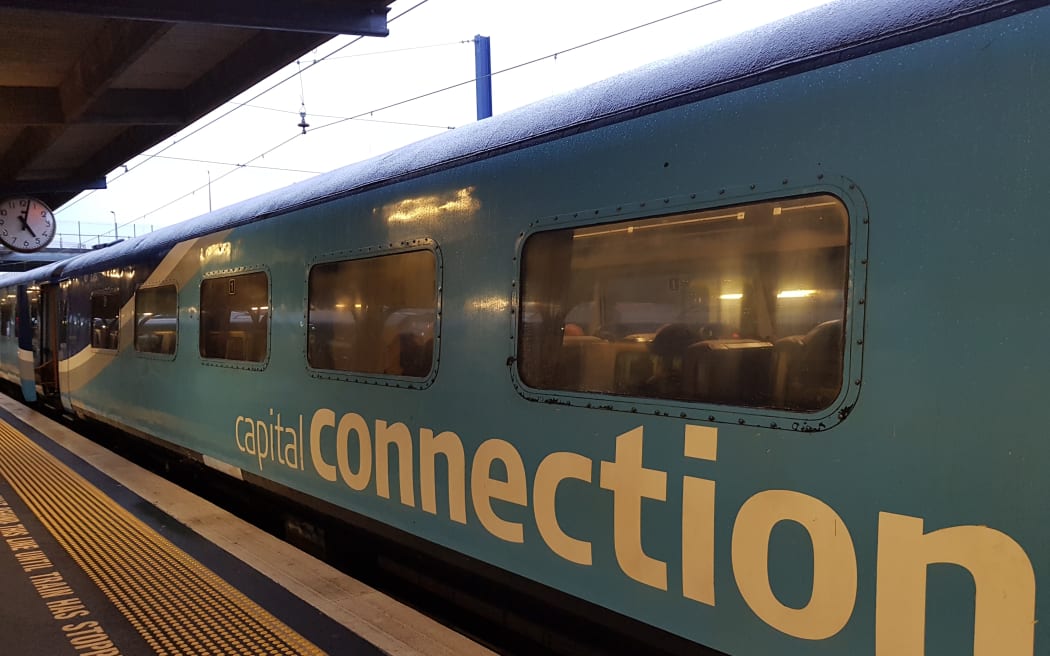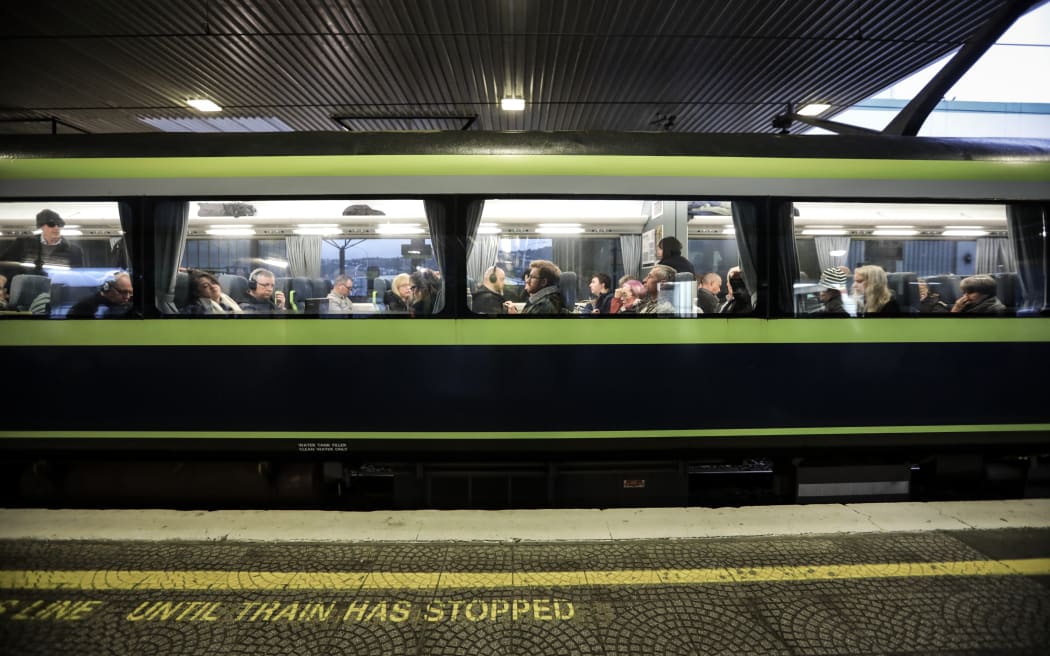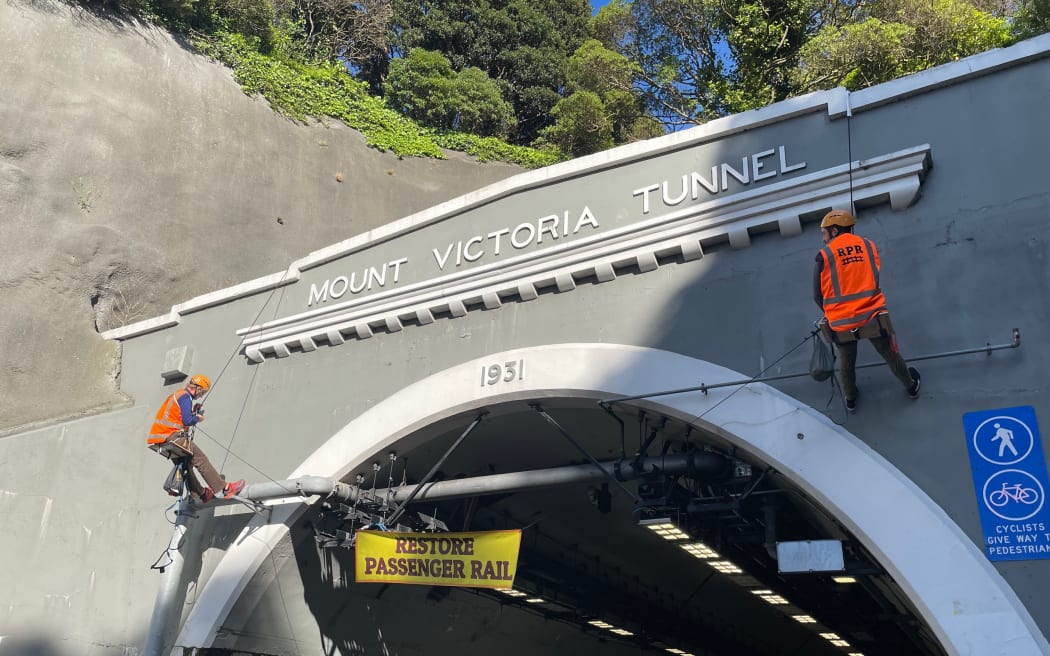
There are only two inter-regional passenger lines in service, including Te Huia (pictured) between Auckland and Hamilton. Photo: RNZ / Gill Bonnett
Protesters have been stopping traffic around the capital for the past two weeks, blocking the Urban motorway and Transmission Gully as well as abseiling down onto the entrance of the Mount Victoria tunnel.
The group responsible are Restore Passenger Rail, whose members have ties to Extinction Rebellion.
They are campaigning for the national train network to be restored to pre-2000 levels, to reduce reliance on cars and lower carbon emissions - but what would this actually look like?
Indeed, the train network of the 2000s looked very different to the way it looks today.
It was privately owned by a company called Tranz Rail, and only bought back by the government in 2008 with the establishment of KiwiRail.
At the turn of the millennium, there were 10 inter-regional passenger lines in service.
Today, there are only two, the Capital Connection from Wellington to Palmerston North, and Te Huia between Auckland and Hamilton - the rest of them carry freight or high-paying tourists.

Capital Connection, which goes from Wellington to Palmerston North, is the other remaining inter-regional passenger line service. Photo: RNZ / Emma Hatton
KiwiRail said a major driver behind its predecessor's decision to close those routes in the early 2000s was low patronage.
But in Western Australia, Curtin University history lecturer Andre Brett said that was not the whole story.
"Fundamentally, the New Zealand rail network was so run down and the rail services so attenuated that, of course, there were so few passengers," Brett said.
"This was the outcome of decades of policy that disregarded passenger needs, that did not seek to grow passenger custom or even retain existing custom."
The state of the rail network today was comparable to the 1930s, he said - if the State Highway network was in the condition it was 90 years ago, there would be national outrage.
While passenger numbers and routes were dropping between regions, suburban commuter routes were on the rise.
KiwiRail data showed metro services in Auckland grew from about 2.5 million passenger trips a year in 2003, to 22 million in 2019.
In Wellington, there were 10 million passenger trips in 2003. Now there are more than 14 million.

KiwiRail data showed metro services in Wellington went from 10 million passenger trips in 2003 to now more than 14 million. (file photo) Photo: RNZ / Rebekah Parsons-King
Greater Wellington Regional councillor Thomas Nash said work was planned in the region to replace the signalling, introduce double tracking at pinch points, and replace the ageing fleet with new trains.
"We put together a business case for new trains, new rolling stock, that would be able to carry far more people and would also be able to run between Wellington and Palmerston North, and also Wellington and Masterton," Nash said.
A daily night service between Wellington and Auckland could also be on the cards.
Any new trains would likely be electric, Nash said.
"We do have overhead wires on most of the North Island main trunk line," he said.
"The new trains that we are proposing to procure in the Wellington region would have batteries on-board, so when there isn't overhead electricity, that battery would kick in.
"So you'd have very low emissions.
"We could make a huge amount of progress in the next 10 years, if we decided to go now.
"I've got a little 1-year-old boy, and by the time he's a 10-year-old, he should be able to be jumping on a train to many new destinations around the North Island."

Two protesters from the Restore Passenger Rail group abseiled down the Hataitai side of the Mt Victoria Tunnel in Wellington and hung a sign saying 'Restore passenger rail' on 18 October. Photo: RNZ / Kate Green
But protester Te Wehi Ratana, who abseiled from a rope over the Mount Victoria Tunnel entrance on Tuesday, said it was not happening fast enough.
"My kids' future depends on us as a society fixing this now, not in 10 years' time," Ratana said.
About an hour later, Ratana was arrested, along with more than 20 others who blocked main highways in Wellington over the past week.
The pace of government was frustrating for some, but work was underway.
Transport Minister Michael Wood said $8.6 billion had been invested since 2017, replacing track and putting in new culverts.
It was crucial work before considering whether to introduce more passenger services or more freight services too, he said.
Moving things by rail produces 70 percent fewer emissions per tonne of freight, compared with by truck.


